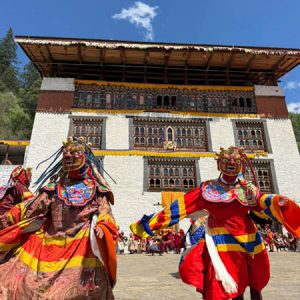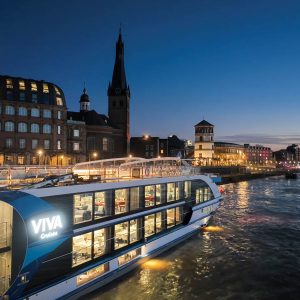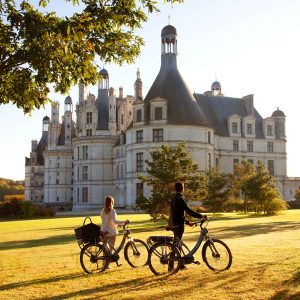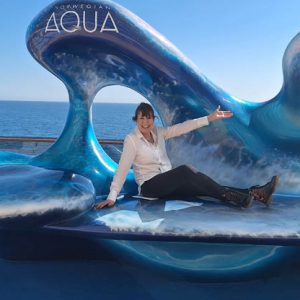If there’s one thing I really appreciate, it’s value for money. So when we discovered that the buses in the Seychelles operate a flat rate fare of five rupees (about 30 pence) for any journey, we decided to go exploring.
It was quite an experience.
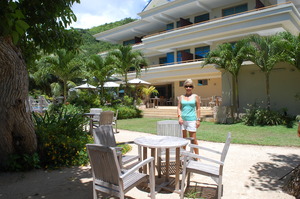 We’d mentioned our plans to Alice, the wonderful, ever helpful manager of our hotel, the Crown Beach, set on a stunning bay on the quiet, southeast coast of the main island, Mahe.
We’d mentioned our plans to Alice, the wonderful, ever helpful manager of our hotel, the Crown Beach, set on a stunning bay on the quiet, southeast coast of the main island, Mahe.
“Yes” she said, in her husky French accent. “You absolutely must try the buses … at least once. But you may not want to do it again!”
My husband, Jim, and I always look for a taste of adventure on our travels. And so, in the steaming heat of this lush, tropical isle, we trotted off to the bus stop, conveniently positioned just opposite the hotel. We were heading for the capital, Victoria, about half an hour or so up the coast.
The rules of engagement for Seychellois bus drivers became apparent alarmingly quickly:
Swerve violently towards your waiting passengers at the bus stop to acclimatise them to the forthcoming journey.
Ensure the bus is full to capacity, with standing passengers hanging from handrails, armpits fully exposed.
Turn off all fans and make sure no air con.
Drive at breakneck speed at all times, regardless of bends or other traffic.
Overtake only when guaranteed to thrill.
Act as if each bus stop is a total surprise to you, causing you to lurch sharply into it with maximum screeching of brakes.
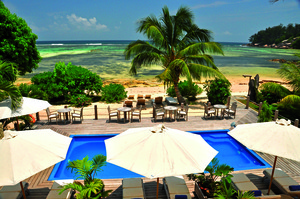 We were the only Europeans on board, and we found the whole journey exhilarating. In fact we took several more rides during our stay. Alice had told us that, despite appearances, the buses have very few accidents. And we arrived in Mahe’s bustling little capital feeling energised by our experience.
We were the only Europeans on board, and we found the whole journey exhilarating. In fact we took several more rides during our stay. Alice had told us that, despite appearances, the buses have very few accidents. And we arrived in Mahe’s bustling little capital feeling energised by our experience.
The city was named after Queen Victoria in 1838, almost 25 years after the islands were ceded to Britain by France. It’s obviously the administrative centre, and it’s worth a look, but it’s also the starting point for most trips to the other islands.
I hadn’t realised that the Seychelles comprise more than a hundred islands, though the majority of the population live on Mahe, Praslin and La Digue. Our stay was only a few days, as we were joining a cruise, so we decided to concentrate on Mahe.
Most of the hotels, and tourists, are in the northwest of the island. So we were delighted to find that Saga had chosen a tranquil oasis for us, on the opposite coast, far from the madding crowd.
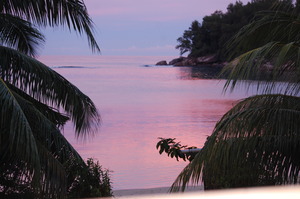 The Crown Beach is a relatively new, boutique hotel with just 14 rooms. Ours was spacious and comfortable with a glorious sea view. The bed was comfy, the balcony huge and even the bathroom had a panoramic vista of the palm trees and ocean. Overhead, huge fruit bats soar majestically, while the myriad Mynah birds chirp noisily from dawn till dusk.
The Crown Beach is a relatively new, boutique hotel with just 14 rooms. Ours was spacious and comfortable with a glorious sea view. The bed was comfy, the balcony huge and even the bathroom had a panoramic vista of the palm trees and ocean. Overhead, huge fruit bats soar majestically, while the myriad Mynah birds chirp noisily from dawn till dusk.
The bay is protected by a reef, so the water is always calm, but it’s also very shallow. So we tended to use the pool more than the sea.
In the evenings, we ate outside by candlelight and solar powered lanterns. The menu was unchanging but good. We particularly enjoyed the fresh fish with ginger, and the spicy curries. And Alice went out of her way to see that we were happy: one night we found she’d instructed her Indian chef to make a special lamb curry just for us. It had taken him most of the afternoon, and it was delicious.
If you don’t fancy the buses, a good way to see the island is to hire a car. At about £50 a day, it’s a convenient way to travel. The roads are reasonable and they drive on the left. We managed to get almost the whole way round the island in about six hours.
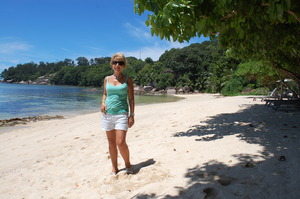 On the way, we discovered the most glorious beaches. L’Intendance, in the far south, is breath-taking, and the water was the clearest and warmest I’ve encountered anywhere in the world.
On the way, we discovered the most glorious beaches. L’Intendance, in the far south, is breath-taking, and the water was the clearest and warmest I’ve encountered anywhere in the world.
The mountain road which crosses the island looks terrifying on the map; a twisted serpent of zig-zag turns. In reality, it’s quite tame and there are some fabulous viewpoints. We stopped at the ruins of the Mission Lodge, where the children of slaves were schooled by British missionaries. The viewing platform, which was opened by our present Queen nearly 50 years ago, is a wonderful vantage point, and a great place to spot birds , like the exotic white-tailed Tropic Bird.
If you go at the right time of year, you might be lucky enough to see Hawksbill sea turtles nesting on some of the beaches. Some eggs had apparently hatched on our hotel beach in January.
The Seychelles are also home to some of the world’s few giant tortoises. But we shall have to return to see these sights. It will entail venturing further afield to some of the other islands. It’s all possible by boat, plane or helicopter.
But there will be no thrilling bus rides to those outer isles … and no five rupee fares!
Silver Travel Advisor recommends Saga Holidays

